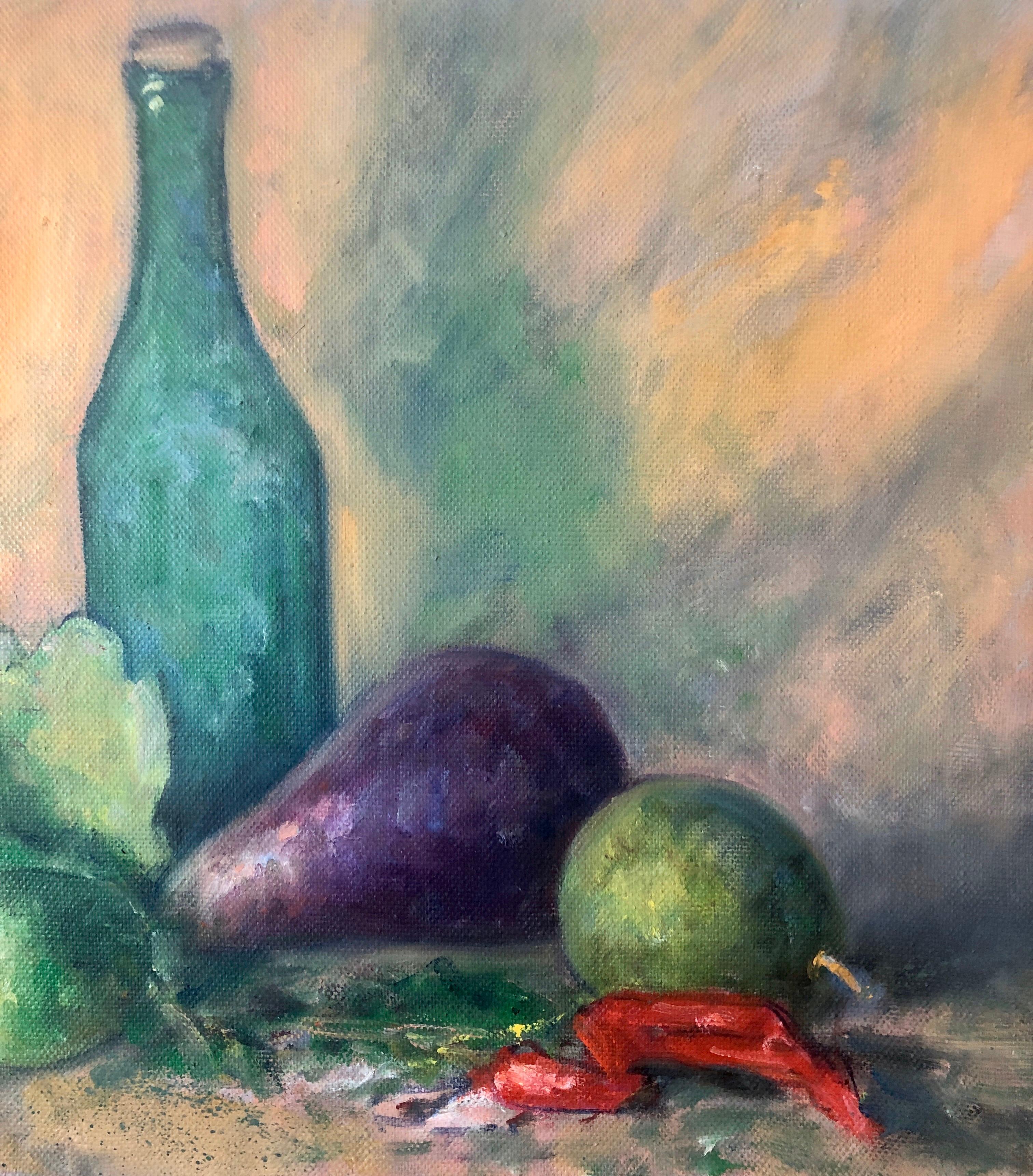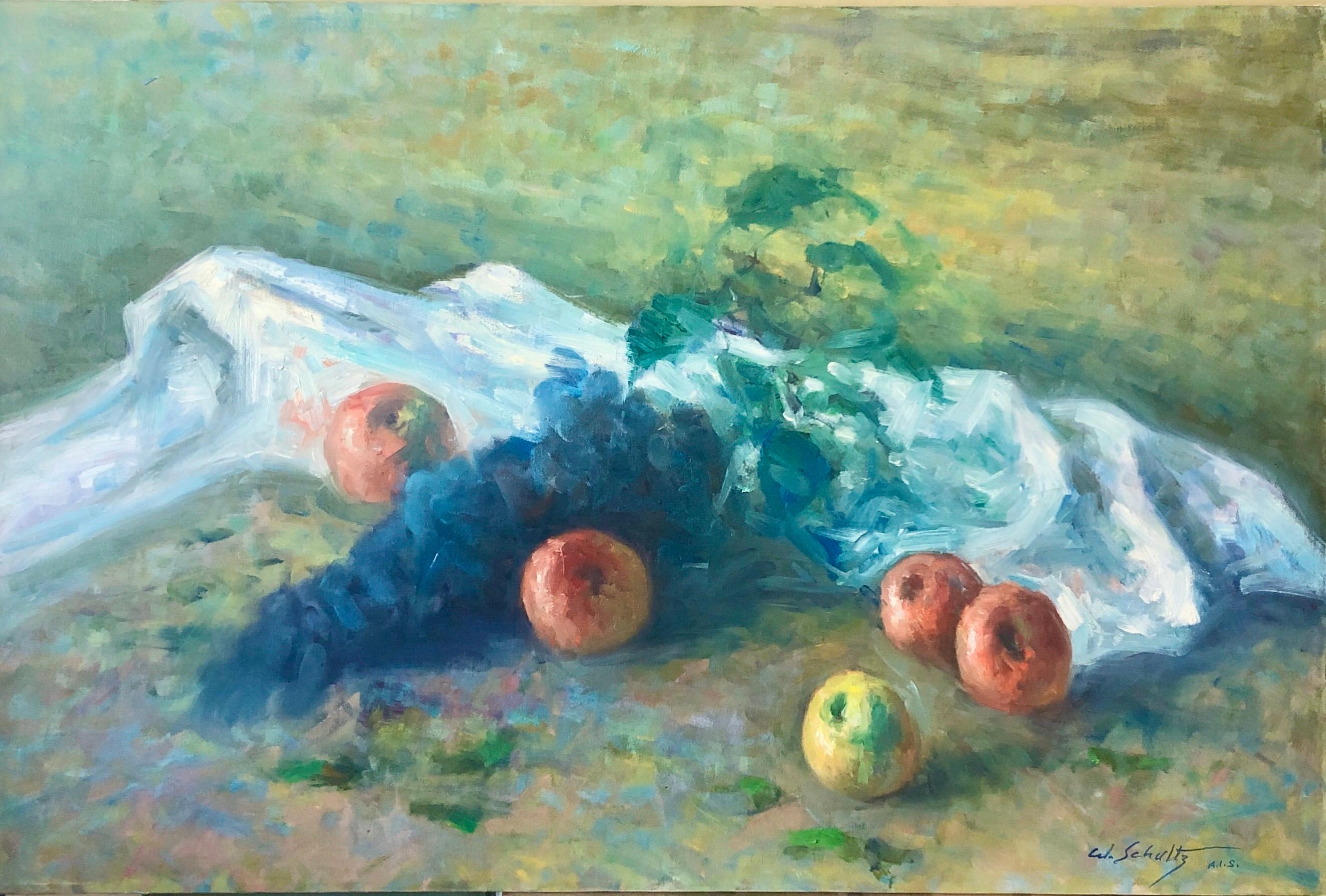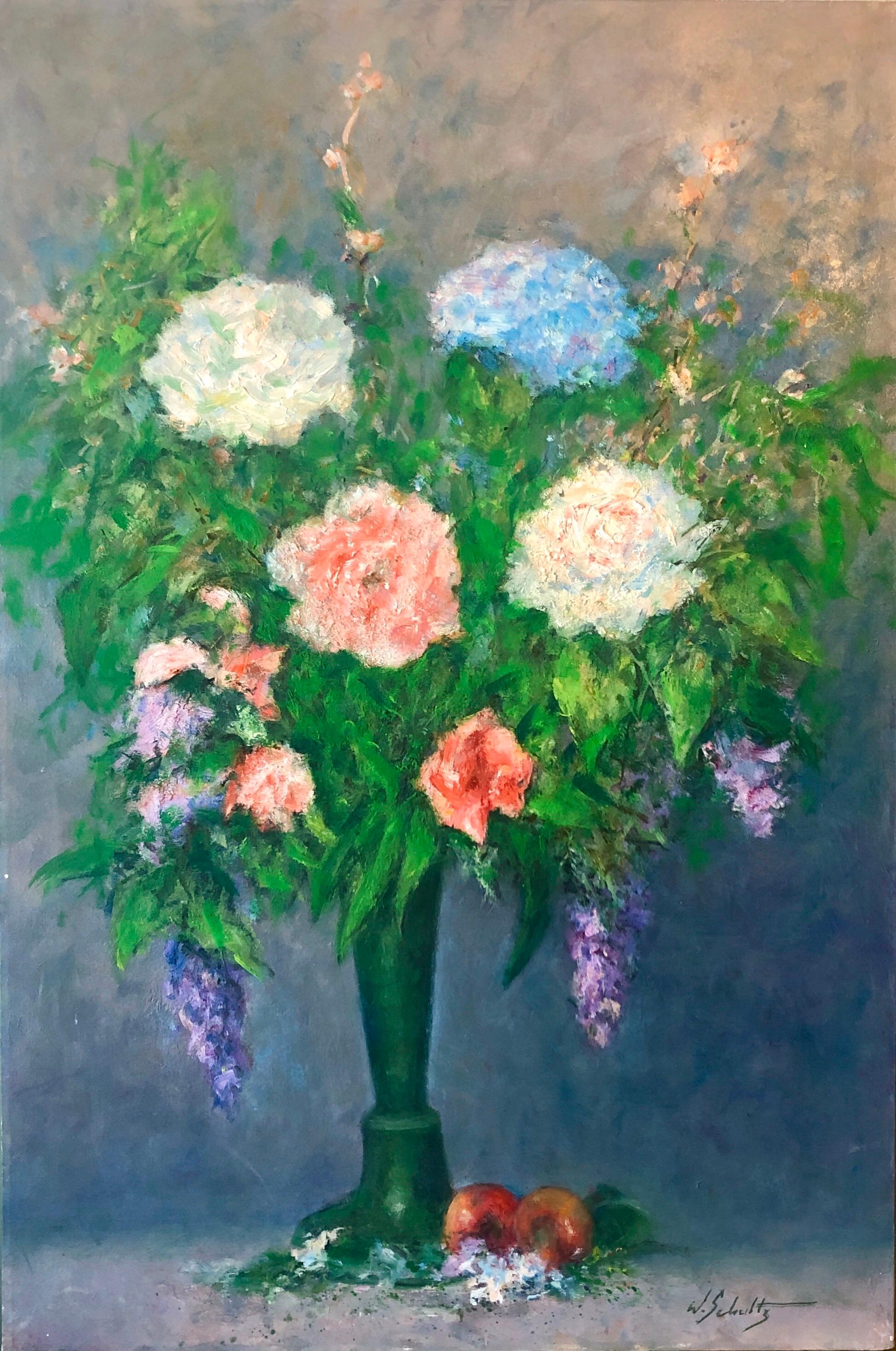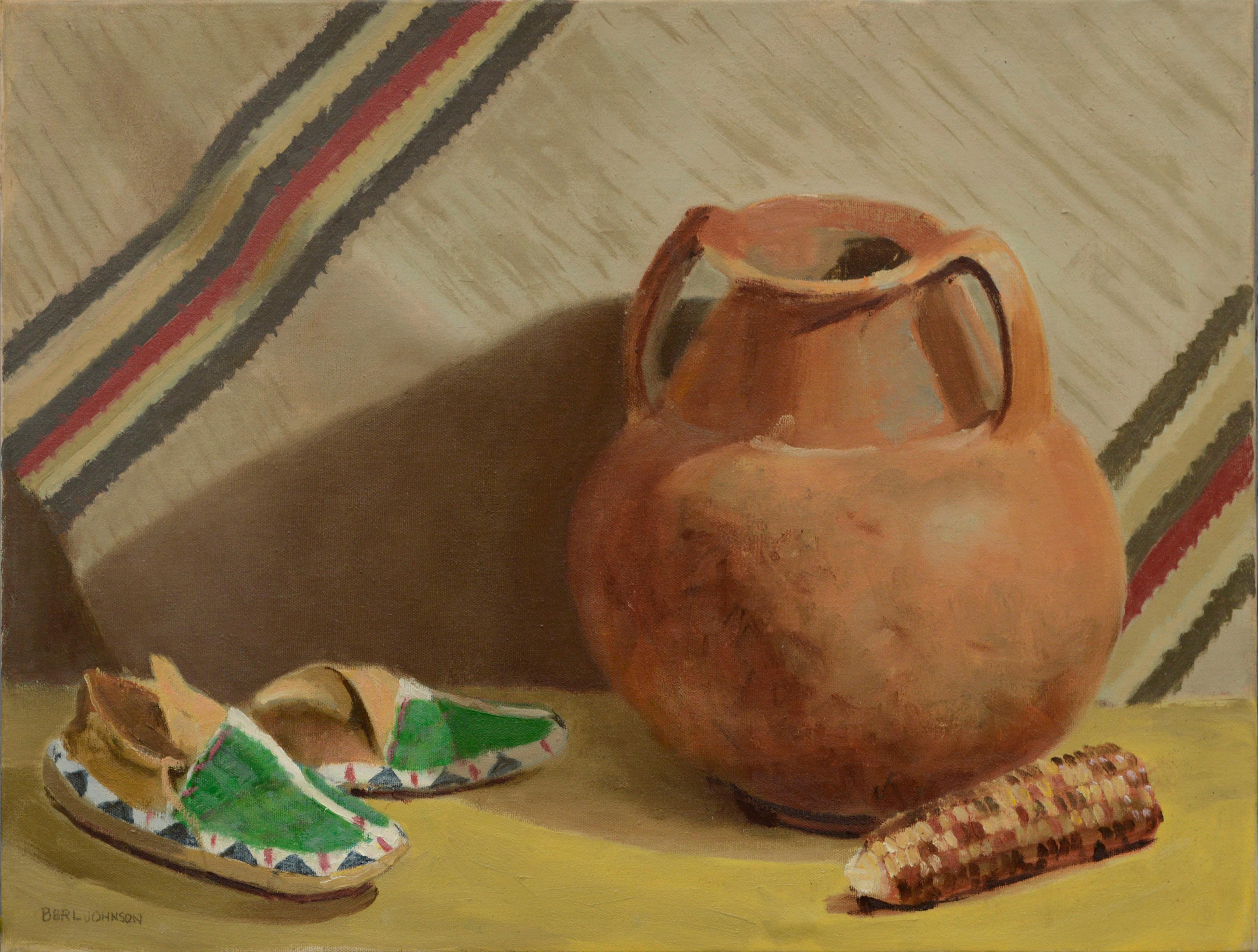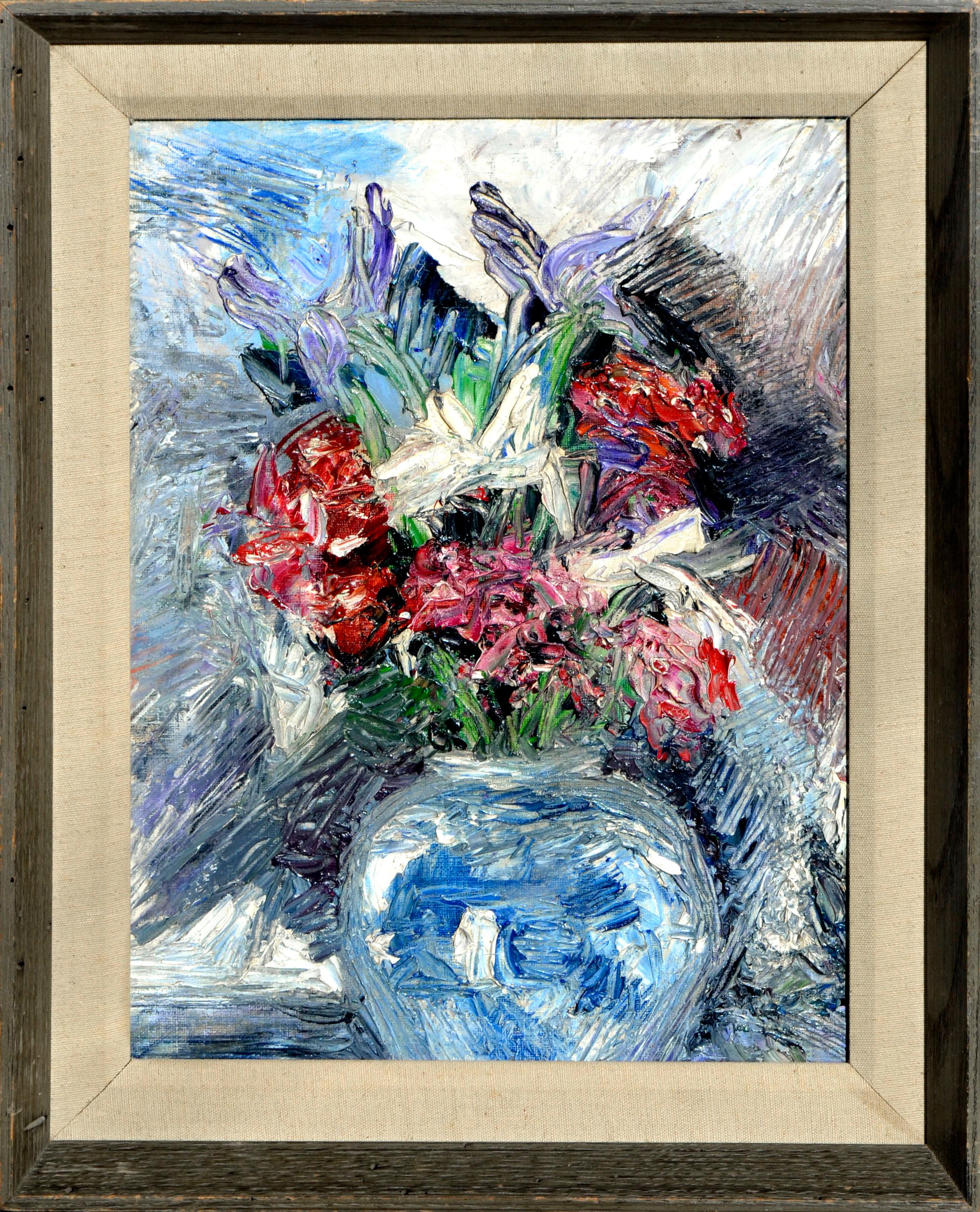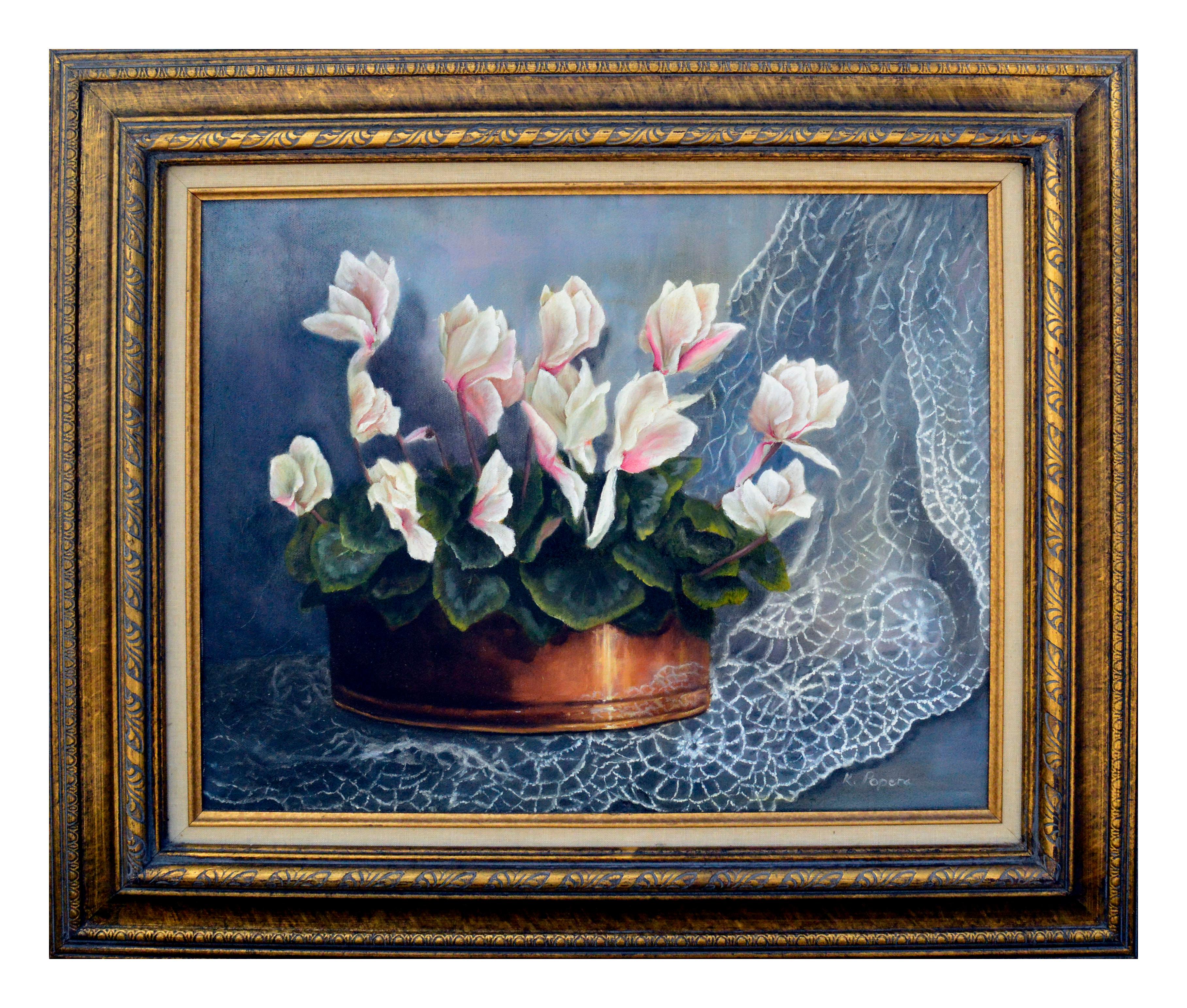Items Similar to Lilies
Want more images or videos?
Request additional images or videos from the seller
1 of 11
Jane PetersonLilies
About the Item
Jane Peterson (1876-1965)
Lilies
Oil on canvas, 1952-1953
Signed by the artist lower right: JANE PETERSON
(see photo)
Painting size: 29 x 23 inches
Frame size: 38 x 32-1/2 x 1-1/2 inches
Exhibited: The Pennsylvania Academy of the Fine Arts: One Hundred and Forty Eighth Exhibition of American Painting and Sculptures, January 25-March 1, 1953
(Photo of original label). Original tacks on stretcher where label was afixed. Label stolen while on exhibition.
Exhibited: Childs Gallery, Boston, 2019- 2023
Jane Peterson was an artist who achieved significant critical attention and adulation over the course of her career. Following her first American solo exhibition in 1909, a critic observed, “There is not a dull canvas in the entire collection and everything is interesting”.1 Thirty-five years later, Historical Records published her biography in the almanac Prominent Women of New York.2 Regardless of her success, Peterson remained pragmatic as she always sought to challenge herself with new ideas and techniques. She spent a lifetime immersed in the practice of painting; as a student, teacher, and gifted artist.
Peterson was a painter with little interest in self-promotion or the conventional achievements of an artist, as a result there has only been a moderate body of scholarship written about her posthumously. Peterson’s legacy is her brilliant oeuvre of impressionistic paintings, held by collections such as the Metropolitan Museum of Art, the Philadelphia Museum of Art, and the Brooklyn Museum of Art.
"Jennie Christine Peterson was born in Elgin, Illinois in 1876. From an early age Peterson, who was known throughout her life as Jane, showed a natural talent for drawing. As a teenager, having received no formal art training, Peterson sat the art aptitude test conducted by the Pratt Institute. The results were promising and, in 1895, Peterson moved to New York to study at the Pratt Institute in Brooklyn.
Peterson thrived at Pratt as a conscientious student, although it was not an easy time for her financially. When her money ran low Peterson gave art lessons to other students, and also earned some income through the sale of her paintings in student exhibitions. When Peterson graduated in 1901, she began working as Drawing Supervisor of Public Schools in Brooklyn. She also continued her art education taking classes at the Art Students League. Between 1904 and 1906 Peterson worked as an art teacher in New York, Massachusetts, and Maryland. In 1907, Peterson sailed to Europe where she visited artists and museums in France, Holland, and Italy. She found Europe to be more socially progressive for women artists and decided to stay and continue her art education.
While in Europe, Peterson studied under Frank Brangwyn at the London School of Art, before relocating to Paris where she received instruction from Jacque-Emile Blanche, Charles Cottet, and Claudio Castelucho. Throughout 1908, Peterson was extremely productive, creating many works in her spare time while also taking on portrait commissions to augment her income. She lived in rooms in Montparnasse located around the corner from Gertrude Stein’s salon, where on Saturday evening artists and art enthusiasts would gather to view and discuss Stein’s seminal collection of Modern art. Attending these events Peterson surrounded herself with powerful art luminaries such as Pablo Picasso, Henri Matisse, Georges Braque, André Derain, and Henri Rousseau.
Peterson’s style from this period is neither entirely academic nor avant garde. Rather she blends the technical skills of her academic training with the loose brushwork and bold color palette of her contemporaries to produce paintings that are beautiful impressions of life. Peterson’s early oil paintings from Europe often show flat generalized areas of color contrasted with skilled detailing – brickwork, window frames, clothes, etc. – that perfectly conjure a scene.
While in Paris, Peterson exhibited her work at the Société des Artistes Français. Then, in 1909, she had her first American exhibition at the Botolph Club, Boston. Favorable reviews ensured this exhibition marked a decisive point in her career, as she shifted from diligent student into the role of a mature artist. However, despite her success Peterson’s single-minded passion for painting kept her open to experimentation new techniques, as she considered perpetual learning and re-learning to be essential practices for an artist. Following two more successful solo exhibitions in 1909, Peterson returned to Europe where she commenced studying with the acclaimed Spanish artist Joaquín Sorolla y Bastida in Madrid.
Of all her teachers, Sorolla had the most influence upon Peterson’s style. Sunlight-drenched Spanish scenes characterize Sorolla’s works. After 1909, Peterson’s canvases become more daring with color, as layers of loose brushstrokes combine to represent the shimmer of Summer’s light in southern Europe. In 1910, Peterson travelled alone to Egypt and Algiers – an extremely brave move for a woman in the early 20th century – where she did a series of paintings in her new bold style. These works were exhibited later that year in a solo exhibition at the Art Institute of Chicago.
In 1911, Louis Comfort Tiffany invited Peterson to his estate, Laurelton Hall, in Oyster Bay, Long Island. Peterson remained at Laurelton for many months, painting the estate’s magnificent gardens. Her love for nature, particularly flowers, would become a subject matter that would increasingly occupy her work. She stated later in life, “I adore gardens! They are the most elusive art of a nation.”3 After 1912, Peterson worked increasingly with gouache as the medium allowed her more freedom for painting en plein air and experimenting with quick strokes of color. She often combined charcoal with gouache, as drawing details with charcoal allowed Peterson to be even more free and light with her paint. Between 1913 and 1919 Peterson worked as a watercolor instructor at the Art Students League.
During the 1910s and 1920s Peterson continued to travel extensively overseas, taking solo painting trips to France and Turkey. Closer to home, she visited Canada, Alaska, California, Florida, and the states of New England. As a result of her adventures around the globe, many of Peterson’s subjects are quite internationally debonair and socially minded in an era when many women favored painting domestic scenes of women and children. For example, during World War One, Peterson joined the war effort painting military portraits and patriotic scenes of women rolling bandages and folding blankets at the Red Cross Center. Spending six months in Turkey in 1924, she painted streets scenes in the Islamic cities of Constantinople and Broosa.
In 1925, Peterson married Moritz Bernard Philipp, a successful corporate lawyer. The couple moved to five-story home on Fifth Avenue in New York City, directly opposite the Metropolitan Museum of Art. A sixth story was added to their home to be Peterson’s studio. After her marriage Peterson focused on flower painting, a subject that would occupy her practice for the rest of her life. She explains:
[Flowers] scintillate the prismatic hues of the rainbow; they harmonize the pastel shades of the night; they are all that is delicate; all that is lurid, brilliant, bizarre. They are living things with personality and refinement, with delicacy of form and structure, with variety of size and shape, with rhythm and charm of arrangement, with grace and dignity of bearing.4
Peterson approached flower subjects with the same intense single-minded passion that drove her to travel solo around the world. She analyzed flowers as mysterious objects of beauty that required diligent attention and sensitive expression. Flowers were by no means an undemanding subject for Peterson.
After Philipp died in 1929, Peterson continued to travel frequently. Throughout the 1930s and 1940s she often spent Summer in Europe, Fall and Spring in New York, and Winter in Palm Beach, Florida. In 1938, she studied with the Modernist André Lhote in Paris. During this time Peterson continued to paint her ‘flower portraits’, and she had numerous exhibitions in New York and Florida.
By the mid-1950s arthritis had affected Peterson’s hands so badly that she could only paint occasionally. Peterson spent the last five years of her life living with her niece in Kansas. She died in 1965.
Since Peterson’s death, her works continue to be highly coveted by collectors. This is due partially to her artistic oeuvre not fitting neatly into a single movement of art history. Peterson’s love for painting floral arrangements is not consistent with her contemporaries’ ideas of the avant-garde. However, while Peterson painted gardens, town squares, and beach scenes in an impressionistic representational style, she was also – like her Modernist peers – pushing the boundaries of an accepted norm. Peterson’s biography is a testament to her passionate, and very determined quest to depict beauty. She persevered against the conventions of her modest upbringing to establish a career as an artist, and she preserved against the conventions of her gender to establish herself as an independent and internationally experienced artist. As a result, Peterson’s flower portraits and international landscapes are a tribute to her adventuresome spirit and resolve to capture elusive beauty on canvas." Courtesy Questroyal Fine Art
- Creator:Jane Peterson (1876-1965, American)
- Dimensions:Height: 29 in (73.66 cm)Width: 23 in (58.42 cm)
- Medium:
- Movement & Style:
- Period:
- Condition:
- Gallery Location:Fairlawn, OH
- Reference Number:
Jane Peterson
Jane Peterson's most innovative period was from 1910 to 1930. During this time she produced her most important work. Her trips to Venice resulted in exuberant paintings full of glowing color. This painting is from that period. The brushwork is bold and exciting. The bright round yellow carob flowers contrast with the vertical mauve carob pods. The trunks and branches of the trees form a series of triangles that reflect the lush Mediterranean landscape. Originally the painting was sold in Paris to an American collector. Jane Peterson was a leading woman post-impressionist painter of the early 20th century. Born in Elgin, Illinois, on November 28, 1876, she was interested in art throughout her childhood. In 1895, she went to New York City to study art at Pratt Institute. Before graduating in 1901, Peterson taught painting and became a popular teacher at Pratt. She then became the Drawing Supervisor of Brooklyn Public Schools. She studied oil painting with Frank Vincent DuMond who emphasized a prismatic palette. Subsequently, she studied painting with Frank Brangwyn in London, Jacques Emile Blanche and André Lhote in Paris, and Joaquín Sorolla y Bastida in Madrid. She was influenced by Impressionism and Fauvism during her studies in Paris. In 1924, Peterson's painting, Toilette, received critical acclaim at the New York Society of Painters. Her one-woman show on Fifth Avenue sold out. By this time, she had won numerous awards, was a Fellow at the National Academy of Design, and a member of many art clubs including the American Watercolor Society, Audubon Artists, Pen & Brush Club, and the National Association of Women Artists. In 1925, The New York Times characterized Peterson as "one of the foremost women painters in New York." Known for her colorful, post-impressionistic paintings of Gloucester streets and harbor on Cape Ann; palm trees along the Florida coast; street scenes in Paris, Istanbul, and New York City; and boating views in Venice. Peterson also flamboyantly executed floral subjects and dynamic genre-like portraits. Carob Tree (Ceratonia siliqua) is a small evergreen tree of the Mediterranean coasts. It has dark green, compound leaves with glossy, oval leaflets. In Italy, the carob tree blooms from September to November. Its seedpods, also known as Saint John's bread, are up to 45 centimeters long and are filled with round, hard seeds and a thick pulp. St. John's Bread was probably the husks in the Prodigal Son parable and the seed which is said to have been the original jewelers' carat weight. The Spaniards call it Algaroba, and the Arabs Kharoub, hence Carob or Caroub Pods, Beans, or Sugar-pods. It is also named Locust Pods. These pods are grown in southern Europe for feeding domestic animals as well as for human food. Carob is sold in health food stores and is often a substitute or alternate to chocolate.
About the Seller
5.0
Recognized Seller
These prestigious sellers are industry leaders and represent the highest echelon for item quality and design.
Platinum Seller
These expertly vetted sellers are 1stDibs' most experienced sellers and are rated highest by our customers.
Established in 1978
1stDibs seller since 2013
712 sales on 1stDibs
Typical response time: 1 hour
Associations
International Fine Print Dealers Association
- ShippingRetrieving quote...Ships From: Akron, OH
- Return PolicyA return for this item may be initiated within 10 days of delivery.
More From This SellerView All
- untitled (Peonies)By Frederick Carl GottwaldLocated in Fairlawn, OHUntitled (Peonies) Oil on artist's board, c. 1910-1920's Signed by the artist in ink lower center (see photo) Provenance: Joseph Erdelac, Private Collector, Cleveland, acquired from ...Category
Early 20th Century American Impressionist Still-life Paintings
MaterialsOil
- Full BloomBy Robert HallowellLocated in Fairlawn, OHFull Bloom Oil on canvass, 28 x 21 1/2 inches Signed lower right: Robert Hallowell Provenance: Estate of the artist Marbella Gallery, New York Illustrated in Ma...Category
1930s American Impressionist Still-life Paintings
MaterialsOil
- Still Life with FlowersBy Emil GansoLocated in Fairlawn, OHStill Life with Flowers oil on board, c. 1935 Signed lower left on table cloth (see photo) Done while the artist was in Woodstock, New York in the 1930's Provenance: Weyhe Gallery, New York Joseph Mark Erdelac, noted Cleveland collector of American Art Condition: Excellent Cleaned by Monica Radecki, South Bend Housed in a metal leaf American profile frame by Hackman Frames, Columbus Image/board size: 18 x 15 inches Frame size: 24-5/8 x 21-1/2 x 1-3/4 inches Emil Ganso (1895-1941) Ganso was born in Germany in 1895. At age 14, he apprenticed to a baker and then worked his way to America when he was 17. He worked in bakeries in Scranton, Pennsylvania; and Cincinnati and Akron, Ohio. By 1916, Ganso out of a job, and was living the life of a bohemian in New York City, sometimes on less than 30 cents a week.1 In 1921, Ganso painted a realistic nude on a bedsheet, and was forced by the police to remove it from an exhibition. The bedsheet with the painting was later stolen. He soon had a job baking again at $140 a month, and with time to spare for painting and study. Ganso quit baking in 1925 when a New York dealer gave him financial backing of $50 a week. Ganso prospered from his art after that. His work is in over 15 American museums, and the Print Club of Cleveland awarded him a $500 purchase prize for a wood engraving. A versatile artist, he painted a variety of subjects. (from a profile written by Clyde Singer) Museum holdings : Biblioteque National Paris; Boston Museum of Fine Arts; Brooklyn Museum; Cleveland Museum of Art; Kupferstich Cabinet in Berlin; Library of Congress; Metropolitan Museum of Art; Museum of Modern Art; New York Public Library; Victoria and Albert Museum in London; Whitney Museum of American Art. Exhibitions : (one-man) Weyhe Gallery 1926 - 1946; Washington Irving Gallery 1960; Retrospective at the Whitney 1941; Retrospective at the Brooklyn Museum 1944; William Benton Museum of Art at the University of Connecticut in1976. (1. from an exhibition catalog held at Marti Sumers Graphics in 1978 Courtesy: AskArt Source: Butler Institute of American Art Courtesy of D. Wigmore “Emil Ganso was born in Halberstadt, Germany in 1895 and came to the United States as a teenager. By 1914 Ganso was taking evening classes at the National Academy's School of Fine Arts while supporting himself as a baker. His work was soon identified by Erhard Weyhe who went on to show Ganso's work at the Weyhe Gallery. Ganso first exhibited at the Society of Independent Artists in 1921, as well as at the Salons of America from 1922 to 1925. By 1925 Weyhe Gallery began to represent Ganso which gave him the funds to spend his first summer in the art colony of Woodstock, New York in 1926. Weyhe Gallery continued to exhibit Ganso's work through the 1940s. In Woodstock Ganso met George Ault, Doris Lee, Charles Rosen, Katherine Schmidt, Eugene Speicher, Alexander Brook, Louis Bouché, Konrad Cramer, Leon Kroll, and George Bellows leading Ganso to settle in Woodstock and continue to benefit from Woodstock connections throughout his life. In 1927, the same year he settled in Woodstock, Ganso began to share a studio with Jules Pascin. Ganso printed Pascin's lithographs and prepared paper for him in 1927 to 1928 while Pascin was in America. In 1929 Ganso visited Pascin in Paris. Perhaps it was this Paris trip that sparked Ganso's interest in photography. By 1930 he was exploring photography as an art form, as well as an aid to his art compositions. Konrad Cramer, Yasuo Kuniyoshi, and Russell Lee were other Woodstock artists who joined Ganso in these photography pursuits. Ganso received a Guggenheim Fellowship in 1933 which he used to study and paint in Europe. In the 1930s Ganso also kept a studio at 54 West 74th Street, an artists' building where Walter Pach...Category
1930s American Modern Still-life Paintings
MaterialsOil
- Still Life with Fruit and a PitcherBy Beni E. KoshLocated in Fairlawn, OHEstate stamp verso: Beni E Kosh Collection #436 Frame: 22-1/4 x 16-1/2 x 1-5/8"Category
Mid-20th Century Contemporary Still-life Paintings
MaterialsOil
- Still Life with Vase of FlowersBy Konrad CramerLocated in Fairlawn, OHStill Life with Vase of Flowers Oil on board with incised scraffito, c. 1929-1930 Unsigned by the artist Signed and inscribed verso: "Painting by my father, Aileen B. Cramer" verso, the artist's daughter Signed with the estate stamp verso Exhibited: Gerald Peters Gallery, Konrad Cramer and the Woodstock School, 2000. (label, see photo), Ny-00457-38-C H. V. Allison Galleries...Category
1920s American Modern Paintings
MaterialsOil
- Les Fruits 2By Charles Harris ( Beni Kosh )Located in Fairlawn, OHLes Fruits 2 Oil on masonite, 1967 Signed and titled lower right (see photos) Signed with the estate stamp verso: Beni Kosh Collection #254 (see photo) Condition: Good Board size: 7 ...Category
1960s Contemporary Still-life Paintings
MaterialsOil
You May Also Like
- American Impressionist Fruits, Vegetables and Bottle Oil PaintingBy William SchultzLocated in Surfside, FLWilliam J. Schultz, American (1919 - 2005) William J. "Bill" Schultz had been a renowned American Impressionist artist and teacher for over sixty-five years. Co-Founder, and Director of the AIS had inspired numerous professional artists and teachers through his teaching. He also was a Master Pastelist in the Pastel Society of America and had won many awards for his oil and pastel paintings. Born in Pittsfield, Massachusetts in 1919, he died in Vero Beach, Florida in 2005. He served in the Army in World War II including duty in Europe. He was discharged in 1946 with rank of First Sergeant. Schultz began his art studies with Martin C. Hoy, a fine artist and student of Robert Henri and William M. Chase. He graduated from The Vesper George School Of Art in Boston, Massachusetts in 1949. He then studied under National Academicians Jerry Farnsworth...Category
20th Century American Impressionist Interior Paintings
MaterialsCanvas, Oil
- American Impressionist Fruits Oil Painting Vivid Apples and GrapesBy William SchultzLocated in Surfside, FLWilliam J. Schultz, American (1919 - 2005) William J. "Bill" Schultz had been a renowned American Impressionist artist and teacher for over sixty-five years. Co-Founder, and Director of the AIS had inspired numerous professional artists and teachers through his teaching. He also was a Master Pastelist in the Pastel Society of America and had won many awards for his oil and pastel paintings. Born in Pittsfield, Massachusetts in 1919, he died in Vero Beach, Florida in 2005. He served in the Army in World War II including duty in Europe. He was discharged in 1946 with rank of First Sergeant. Schultz began his art studies with Martin C. Hoy, a fine artist and student of Robert Henri and William M. Chase. He graduated from The Vesper George School Of Art in Boston, Massachusetts in 1949. He then studied under National Academicians Jerry Farnsworth...Category
20th Century American Impressionist Interior Paintings
MaterialsCanvas, Oil
- American Impressionist Floral Oil Painting Vibrant Flowers in VaseBy William SchultzLocated in Surfside, FLWilliam J. Schultz, American (1919 - 2005) William J. "Bill" Schultz had been a renowned American Impressionist artist and teacher for over sixty-five years. Co-Founder, and Director of the AIS had inspired numerous professional artists and teachers through his teaching. He also was a Master Pastelist in the Pastel Society of America and had won many awards for his oil and pastel paintings. Born in Pittsfield, Massachusetts in 1919, he died in Vero Beach, Florida in 2005. He served in the Army in World War II including duty in Europe. He was discharged in 1946 with rank of First Sergeant. Schultz began his art studies with Martin C. Hoy, a fine artist and student of Robert Henri and William M. Chase. He graduated from The Vesper George School Of Art in Boston, Massachusetts in 1949. He then studied under National Academicians Jerry Farnsworth...Category
20th Century American Impressionist Interior Paintings
MaterialsCanvas, Oil
- Mid Century Southwest Still Life -- Hopi RelicsLocated in Soquel, CABeautiful mid century still-life of authentic Hopi Indian relics including terracotta pottery, an ear of corn, and colorful moccasins on a traditional patt...Category
1950s American Impressionist Still-life Paintings
MaterialsCanvas, Oil
- Impressionistic Blue Vase with FlowersLocated in Soquel, CAA dynamic, highly textured impasto mid-century still life of a blue vase with flowers. Unsigned. Displayed in a rustic walnut wood frame. Image,...Category
1950s American Impressionist Still-life Paintings
MaterialsCanvas, Oil, Cardboard
- Spring Garden Flowers Still-LifeLocated in Soquel, CAVivid floral still-life of colorful flowers bursting from a blooming spring garden by an unknown artist (American, 20th Century). Unsigned. Displayed in a rustic wood frame. Image si...Category
1980s American Impressionist Still-life Paintings
MaterialsCanvas, Oil
Recently Viewed
View AllMore Ways To Browse
1911 Elgin
1940s Oyster Perpetual
1953 Oyster Perpetual
Red Cross Tiffany Windows
Tiffany Cross Charm
Tiffany Lily Light
Tiffany Love Charm
1904 Elgin
Tiffany Lily Shades
Womens Oyster Perpetual
Tiffany Window Art Institute
Oyster Bay Tiffany
Tiffany Flower Charm
Tiffany Marriage
Questroyal Fine Art
Military Clothes
Tiffany Brushstroke
Tiffany Chicago Charm
